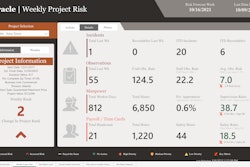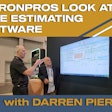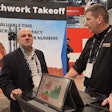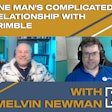
On January 11, Sage announced its acquisition of Bridgetown, a multitenant software-as-a-service (SaaS) collaborative preconstruction software vendor.
Sage adds Bridgetown’s BidMatrix application to its portfolio of construction ERP products, an estimating solution and Sage Construction Project Management, a construction project management application that came through the May, 2023 Corecon acquisition. BidMatrix had already been integrated with Sage Estimating—other standard integrations include Autodesk’s BuildingConnected, Procore, ConstructConect SmartBid and Trimble WinEst.
Collaborative Preconstruction in the Cloud
With Sage Estimating living on the desktop, BidMatrix adds a collaborative layer that can be shared by a general contractor and its subcontractors, and a bid leveling capability to support intelligent subcontractor selection.
With BidMatrix, contractors can:
- Manage scope inclusions and exclusions
- Audit additions or changes in bid packages
- List and manage alternates to ensure the quote aligns with owner and design expectations
According to Bridgetown President and CEO Steve Watt, the company was founded to plug the holes in a general contractor estimating process, notching out ad-hock tools like Excel spreadsheets and other shadow IT.
Watt will now be responsible for Sage’s preconstruction offering, including Sage Estimating. Watt is returning to the Sage family having come into the company with Sage’s 2003 acquisition of Timberline, which is now Sage 300 Construction and Real Estate. His subsequent estimating software company, WinEstimator, was acquired by Trimble in 2012 to become WinEst. Watt went on to found Bridgetown in 2020 to close the gaps he had seen in these earlier offerings. IRONPROS caught up with Watt and Sage Senior Vice President of Product for Construction and Real Estate Julie Adams in the days after the announcement.
“One of the things that we would run into all the time with WinEst is people saying they like our estimating product and can identify with the pitfalls of using Excel to create estimates,” Watt said. “They knew they needed to make a move to a dedicated estimating product. In the general contractor market, they could see how to build up a budgetary estimate. But it is just that—a budgetary estimate. Of course, 85% of the project is subcontracted out. They still needed to analyze subcontractor bids, compare them and pick the optimum mix of subs. Because at the end of the day, profit could evaporate if you’ve got the wrong mix of subcontractors, or are carrying the wrong numbers from subcontractors.”
To solve this problem, BidMatrix allows contractors to import budgetary estimates and use them to compare budgets for each bid package and bid package phase against budgets from subcontractors. Bid packages and bid phases will correspond with work breakdown structure (WBS) codes in software like Sage Estimating. Bid rooms and individual plans in BidMatrix support multiple users at the same time, giving generals and subs a collaborative workspace.
“We allow as many people in an individual trade within an individual project as you need—there’s no limit,” Watt said. “We just heard from one of our customers that they were tackling a huge project and they had broken concrete down into 30 phases of work within concrete foundations, slabs, concrete walls, tilt up, everything. They had bids coming in from 35 concrete subcontractors. They said they had five estimators, not only in the same project, but in that concrete package, all entering subcontractor bids as quickly as they were coming in. They said they actually didn't think they could have done it without BidMatrix.”
IRONPROS gets a first hand look at Sage Estimating with this quick demo.
Win-Win or No Deal
Acquisitions in the enterprise software field can have either a positive or negative impact on the acquired company and its users. With the Bridgetown acquisition, there are quick and easy wins for both Sage Estimating users and Bridgetown customers. The most obvious win is the modernization of the estimating experience as a proven solution like Sage Estimating gains a collaborative layer that can easily insert new and innovative technologies to the preconstruction experience.
“Using these legacy products, how do we use history?” Watt asked. “How do we use AI? How do we use anomaly detection? We were wondering what kinds of things we could do that weren't even possible in any of those legacy systems. So, we did all that. And the reason the Sage acquisition made a ton of sense is they have their current Sage Estimating product. After being involved with Sage but also competing against Sage for many years I would argue today it’s the number one system if you measure it by the number of licenses that are being used to create estimates in North America. Sage estimating is still number one.”
While Watt had been involved directly in estimating software, Bridgetown was founded more as a supplement to these established products in the market. This, and the modern SaaS nature of the product, made it a natural fit for the Sage preconstruction portfolio.
However, Watt wouldn’t consider selling unless the deal met his criteria for a successful acquisition. “An acquisition should check all three of the following: a win for customers, a win for employees, and a win for those that market and sell the product,” said Watt. “The acquisition of Bridgetown by Sage checked all of those boxes for both Bridgetown and Sage.” The Sage acquisition meanwhile gives BidMatrix broad distribution through Sage resellers, and makes it part of a family of products that address small businesses to enterprise-size contractors. This gives the Bridgetown product a leg up compared to other emerging cloud preconstruction solutions like those from Planhub and ConCntric.
With the deal, Sage extends its market-leading estimating product with modern cloud technology, taking data off the desktop and into a shared workspace with dynamic and easily-evolved functionality.
"Sage Estimating is a market-leading estimating solution.” Adams said. “As Steve was saying, a large percentage of estimators are using Sage estimating today. It is a very rich, robust solution. Our approach to combine that solution with a best-in-class, new multi-tenant SaaS platform is unique and offers the best of both worlds. We are not rebuilding Sage Estimating as a cloud product as the first priority. Rather, our strategy is to build complementary value-add capabilities to Sage Estimating made possible by the cloud and eventually reimagine what cloud estimating can become. The combined solution provides immediate benefits today and is the foundation for transforming Sage Estimating in the cloud."
Thanks to a software development kit (SDK) for Sage Estimating, the integration is dynamic, bidirectional and performant.
“When you point to an estimate that you want to have in BidMatrix, we're pulling up the array in real time from the folder that shows all the estimates that exist,” Watt said. “We're reading all that information in real time and pulling all the details in that estimate so it's all available in BidMatrix. We are then pushing it back. So, when our customers go from a budgetary estimate to a bid estimate, they push the bid estimate back to Sage Estimating.”
BOTTOM LINE: IRONPROS has predicted more acquisitions and market consolidation in construction software and technology, and contractors evaluating software will want to ask themselves questions about the future of the products they select. Acquisitions can be disruptive if they are followed by disinvestment, a lack of communication about a combined roadmap or forced migration onto another product in the new owner’s portfolio. More modern products that ease integration and collaboration, and with a strong product-market fit, will fare better whether they are acquired or not. Multi-tennant SaaS products will also tend to be favored after an acquisition. Acquiring vendors like Sage can do all parties a favor with clear communication and by opting for acquisitions that add strong and immediate value with minimal redundancy with existing products, as they have here with Bridgetown.















